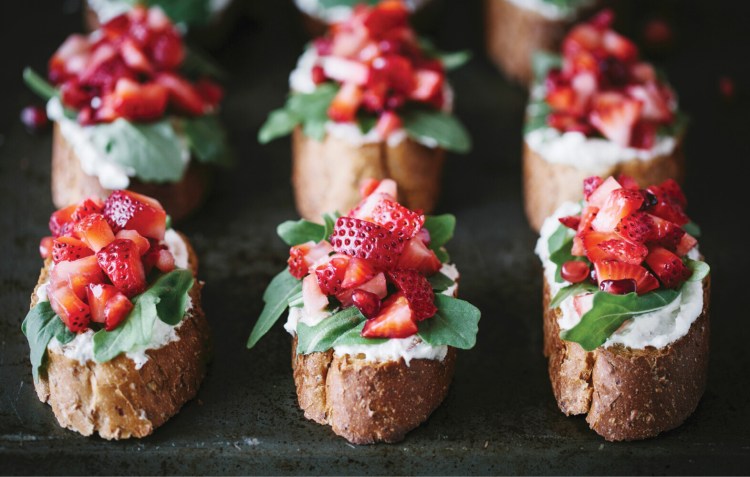Editor’s Note: Green Plate Special columnist Christine Burns Rudalevige is taking a well-deserved vacation. She will return next week.
Kate Shaffer’s latest cookbook, “The Maine Farm Table Cookbook,” is the book I wish someone had given me when I moved to Maine. The cookbook, Shaffer’s third, was published this month and comprises, as its subtitle promises, “125 Homegrown Recipes from the Pine Tree State,” from Lobster Carbonara, and Haddock and Corn Chowder to Maine Maple Old-Fashioned and Apple and Blackberry Crumble. But the title undersells it.
To research it, Shaffer, who founded and owns Ragged Coast Chocolates (formerly Black Dinah Chocolates) in Westbrook with her husband, Steve, visited farms and kitchens across Maine and wrote short profiles that celebrate the state’s millers, chefs, bakers, farmers, aquaculturists, lobsterwomen, beekeepers, tortilla makers, jam makers and more. These solid introductions are interspersed with the recipes and with many photos from Saco-based photographer, food stylist and chef Derek Bissonnette.
The profiles give readers a sense of the impressive breadth and depth of Maine’s farm-and-sea-to-table scene. They tell you about places and people you probably already know — like The Lost Kitchen in Freedom, Pineland Farms in New Gloucester and Maine Grains in Skowhegan. And they tell you about places and people that may be less familiar, especially if you live in the southern part of the state – Tinder Hearth in Brooksville, Quill’s End Farm in North Penobscot, Eat at Joe’s Food Truck in Ellsworth. No slur intended on the recipes, but I’d be as tempted to keep “The Maine Farm Table Cookbook” in my car when I travel the state as a guide, as in my kitchen. That said, it’s a handsome book, but not so handsome that you’d be afraid to keep it in the kitchen, subject to the daily smatters and smudges of cooking.
Shaffer quietly and thoroughly conveys a sense of community and connection among the state’s food producers. On one page you meet a farmer, later on you meet the chef who is buying her lamb. An encounter with Aurora Mills & Farm in Linneus leads to a sideways introduction to some of its customers – Allagash Brewing (which gets its own profile some 250 pages later), GrandyOats, Borealis Breads; likewise, an entry on Tortilleria Pachanga offers a peek at the Somali Bantu community at Liberation Farms in Wales. On page 84, readers get acquainted with Maine’s celebrated organic farmer Eliot Coleman and his wife, garden writer Barbara Damrosch, and learn about their Four Season Farm in Brooksville; on page 148, you’ll run into the farm again, this time as a supplier to Deer Isle’s Aragosta restaurant. Maine is a big state, but somehow, in these pages its food community feels cozy and tight-knit.
“The Maine Farm Table Cookbook” is broken up into apt chapters: From the Mill, From the Field, From the Pasture, From the Sea, From the Forest and the Hive, From the Creamery, From the Orchard; From the Bog, Bramble and Barren; From the Brewery, Vineyard, and Cask; and From the Pantry. Shaffer’s earlier books focus on the sweet side of cooking: “Desserted: Recipes and Tales from an Island Chocolatier” and “Chocolate for Beginners: Techniques and Recipes for Making Chocolate Candy, Confections, Cakes and More.”
The recipes in this cookbook, like its subject matter, are diverse and range from old-fashioned basics such as brown bread, cornbread, biscuits, pot roast, maple baked beans, beef stew and blueberry buckle to newer-fashioned basics like Braised Lamb Shanks with Root Vegetables and Chickpeas; Sliced Lamb Salad with Tomatoes, Feta and Red Onions; and Roasted Squash with Pine Nuts.
There are fun, fascinating tidbits tucked throughout that help you begin to know the state’s food and foodways in a rounded, 360-degree way: how “peeky-toe” crab got its name, also the punning name of Sargentville’s beloved Mexican restaurant El El Frijoles (think about it); how Mainers who are food insecure can get fresh wild fish and game (a state program called Hunters for the Hungry); how Maine’s food sovereignty movement works; how Maine’s sheep production used to be, and is; and how climate change is affecting the state’s foods.
About that last, here’s what Shaffer notes atop a recipe for Sweet Potato and Turnip Soup with Fresh Turmeric: “Because of changing weather patterns, farmers have been able to experiment with crops that aren’t historically grown in Maine, such as sweet potatoes. These days, sweet potatoes and rhizomes like turmeric root are popping up on more and more fall vegetable crop rotations throughout the state. Here they’re paired uniquely in a smooth soup with one of the heartiest of the traditional Maine crops: the turnip.”
But it’s June. So in our kitchen, we’ll leave the turnip for another season and focus on a less hearty, but probably more beloved Maine crop: the strawberry.
Strawberry Bruschetta with Ricotta and Arugula
Recipe from Kate Shaffer’s “The Maine Farm Table Cookbook.” Shaffer suggests a creamy, dense ricotta and adds that if you use Skowhegan-based Crooked Face Creamery’s cold-smoked ricotta, “the smoked flavors mingle magically with the fresh fruit and peppery arugula.”
Serves 8
2 cups fresh hulled and diced strawberries
2 tablespoons pomegranate seeds
Sea salt, to taste
Freshly ground black pepper, to taste
1 baguette
1 cup ricotta cheese
2 cups arugula, washed, and chopped if the leaves are very large
Toss diced strawberries and pomegranate seeds with a pinch of salt and pepper in a mixing bowl. Set aside.
Cut baguette, on bias, into at least 8 slices, preferably more.
Spread slices with ricotta cheese and top with arugula. Spoon diced strawberries and pomegranate on top before serving.
Send questions/comments to the editors.




